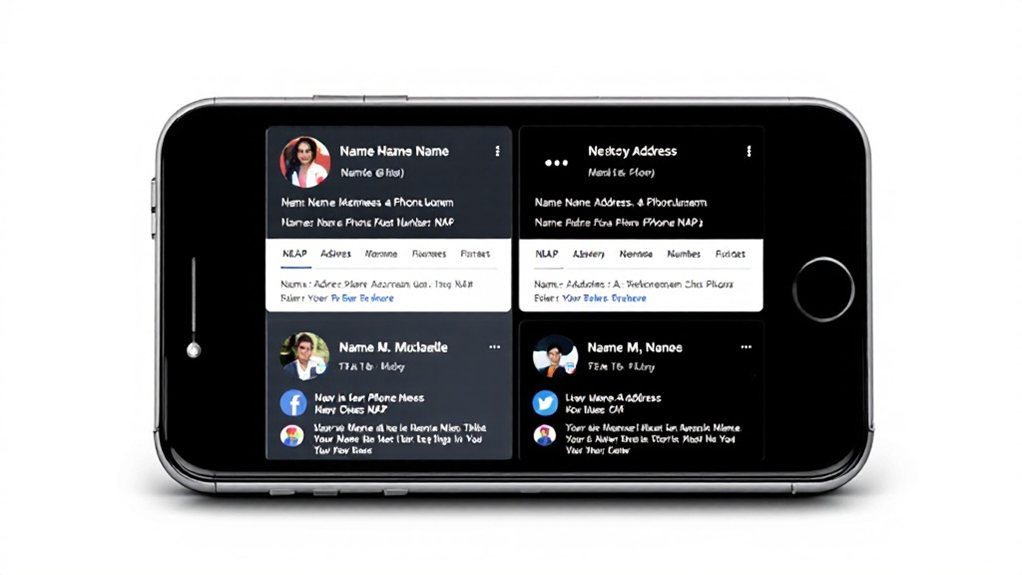To optimize your social media bios for consistent name, address, and phone number (NAP), first standardize the format across all profiles. Use a uniform phone number style, spell out street names, and regularly update any changes. Leverage directory listings to boost NAP consistency, which enhances your local SEO. Conduct regular NAP audits to identify discrepancies and maintain accurate information. Consistent NAP builds trust signals and boosts your visibility in search engine results. There's more you can do to level up your social media bio optimization.
Standardize NAP Format Across Social Media Profiles

Ensuring consistency in your business's name, address, and phone number (NAP) across social media profiles is crucial. Maintain a uniform NAP format to build trust with search engines and customers. Spell out details like "Street" instead of "St.", and use a consistent phone number format, such as "(123) 456-7890." Regularly update your NAP details on social media to reflect any changes, as inconsistencies can damage your business's credibility. Display your NAP prominently on your profiles for easy access, and consider using schema markup to enhance visibility and improve local search rankings. Consistent NAP across social media profiles is essential for local SEO success. Consistency is key – avoid variations in your business name, address, and phone number to ensure a seamless online presence.
Leverage Directory Listings for NAP Consistency

Consistent NAP data across directories is paramount for your local SEO success. Focus on high-impact directories like Google My Business, Bing Places, and Yelp to maximize visibility. Uniform NAP allows search engines to validate your business data, boosting your local rankings. Inconsistent NAP can negatively impact your SEO, so regular audits are essential. Implement schema markup on your website and include NAP in directory descriptions to further enhance consistency. Eliminate duplicate listings and follow each directory's guidelines to ensure accurate NAP entry. Consistent NAP is a significant ranking factor, improving business visibility and user experience. Leverage these strategies to maintain NAP consistency and drive better local SEO results.
Conduct Regular NAP Audits to Identify Discrepancies

Conducting regular NAP audits is crucial to identifying any inconsistencies across your online profiles. Utilize automated tools to scan for NAP discrepancies and manually review your listings to ensure accuracy. Staying on top of these updates will help you maintain a professional and trustworthy business presence. Regularly reviewing and updating your NAP information ensures your business information is consistent across all digital platforms.
Identify Profile Inconsistencies
Regularly auditing your online profiles is crucial to identifying any discrepancies in your business's name, address, or phone number (NAP) data. Review your listings across directories, social media, and review platforms to ensure consistency. Common inconsistencies include variations in your business name, address, or phone number, which can negatively impact your SEO and customer trust. Consistent NAP data is crucial for search engine optimization. To effectively identify profile inconsistencies:
- Leverage online tools like BrightLocal to automate the NAP audit process.
- Carefully review customer feedback, as reviews often highlight NAP-related issues.
- Ensure that your social media profiles display your NAP information accurately.
- Maintain a proactive approach by regularly monitoring for changes in your business listings.
Schedule Regular Audits
Maintaining NAP consistency is an ongoing effort, as your business information can change over time and discrepancies may arise across various platforms. To ensure your NAP remains accurate, schedule regular audits, such as quarterly, depending on your business's dynamics and size. Use tools like BrightLocal or Moz Local to efficiently scan for inconsistencies and generate detailed reports. Correct any found discrepancies promptly, and maintain documentation of the changes made. Engage with customer feedback, as it can highlight NAP issues you may have overlooked. By scheduling consistent audits and taking prompt action, you'll maintain the trust of customers and search engines, boosting your local SEO performance. Consistent audits can help identify and address NAP discrepancies promptly.
Enhance Local SEO Through Consistent NAP
Why is consistent NAP (name, address, and phone number) data crucial for enhancing your local SEO efforts? Inconsistent NAP information can negatively impact your search engine rankings, as Google uses this data to verify your business legitimacy. Consistent NAP across all online platforms, including your website, social media profiles, and local listings, boosts your visibility in local search results and helps you attract more customers.
To optimize for NAP consistency:
- Standardize your business information across all platforms.
- Ensure accurate address formatting and spelling.
- Monitor and update your online listings regularly.
- Leverage SEO tools to manage and track your NAP consistency.
Maintaining consistent NAP data gives you a competitive edge in local search, driving more potential customers to your business.
Build Trust Signals With Accurate NAP
Consistent and accurate NAP (name, address, and phone number) data across your digital platforms sends a powerful trust signal to both customers and search engines. When your NAP information is consistent, it demonstrates the legitimacy and reliability of your business, which can increase trust and boost your search engine rankings. Consistent NAP data can also improve the visibility of your local business on search engine results pages (SERPs).
To further build trust signals, consider the following strategies:
| Strategy | Impact |
|---|---|
| Optimize social media bios | Maintain NAP consistency across all profiles |
| Automate NAP updates | Prevent errors and ensure uniformity |
| Use reputation management tools | Track and manage NAP data efficiently |
| Conduct regular NAP audits | Identify and correct any inconsistencies |
| Tailor solutions for your business | Ensure flexibility in maintaining NAP consistency |
Optimize Social Media Profiles for NAP-Friendly Schema Markup
Optimizing your social media profiles with NAP-friendly schema markup is a powerful way to reinforce your business's credibility and improve local search visibility. By leveraging schema.org vocabulary and JSON-LD markup, you can effectively communicate your NAP details to search engines, enhancing your online presence.
Here are 4 steps to optimize your social media profiles for NAP-friendly schema markup:
- Implement the LocalBusiness schema type to include your NAP and social profile links.
- Utilize the "sameAs" property to interconnect your social media profiles.
- Ensure your schema markup is not blocked by robots.txt and is published on a publicly accessible webpage.
- Regularly audit and update your NAP information across all platforms to maintain consistency.
Maintain Consistent Messaging in Social Media Bios
Maintaining consistent messaging across your social media bios is crucial in establishing a strong brand identity and improving online visibility. Craft a concise "one-liner" that encapsulates your brand message, and ensure it is uniform across all platforms. Tailor your bio to each platform's character limits, and align it with your overall marketing strategy. Clearly communicate your brand's values, unique offerings, and mission, and incorporate relevant keywords for search visibility. Employ consistent visual branding, using imagery and graphics that align with your identity. Adapt your bio to each platform's audience and tone, and update it as your content strategies evolve.
| Character Consistency | Brand Identity | Visual Elements |
|---|---|---|
| Develop a "one-liner" | Communicate brand values | Use consistent visuals |
| Use consistent formatting | Highlight unique offerings | Optimize images for accessibility |
| Tailor bio to platform limits | Incorporate brand keywords | Maintain visual style consistency |
Leverage Engagement Metrics to Boost Social Media SEO
Engagement metrics like likes, shares, and comments can give you valuable insights to boost your social media SEO. Engagement metrics provide concrete data on the engagement, informativeness, and value of content. These social signals influence search engine rankings, so you'll want to track and optimize for them. Leveraging engagement data can also help you improve visibility and grow your revenue.
Leverage Likes, Shares, Comments
Your social media engagement metrics can be a powerful tool to boost your SEO efforts on these platforms. By leveraging likes, shares, and comments, you can enhance your online visibility and credibility.
- Monitor your content's engagement to identify high-performing posts and optimize your strategy accordingly.
- Encourage users to interact with your content by posing questions, running polls, or using compelling visuals.
- Utilize relevant hashtags to increase your content's discoverability and attract your target audience.
- Analyze engagement data to gain insights into your audience's preferences and refine your content creation process.
Harnessing the power of social media engagement can have a significant impact on your overall SEO performance.
Social Signals Influence Rankings
Social signals play a crucial role in boosting your social media SEO. High engagement signals like likes, shares, and comments help verify your content's relevance and popularity, indirectly influencing search engine rankings. These interactions amplify your content's reach, making it visible to a broader audience. Additionally, strong engagement metrics indicate your brand's authority and trustworthiness to search engines. By monitoring your analytics, you can identify patterns in user behavior and adjust your strategies accordingly. Ultimately, leveraging social signals can drive more high-quality traffic to your website, improve user behavior metrics, and increase your overall online visibility.
Grow Revenue Through Visibility
By leveraging engagement metrics, you can effectively boost your social media SEO and grow your revenue. Track engagement rate, likes, comments, shares, and video completion rate to gauge content resonance and shareability. Use this data to align your content strategy with what your audience finds most engaging. Additionally:
- Monitor engagement metrics regularly to identify high-performing content and adjust your strategy accordingly.
- Correlate engagement metrics with SEO results to understand how audience interaction impacts visibility and discoverability.
- Utilize engagement data to refine your keyword strategy and create more targeted, SEO-driven content.
- Analyze engagement across platforms to optimize your approach and ensure consistent performance.
Utilize Clear and Engaging Language in Social Media Bios
Why settle for a forgettable social media bio when you could craft a captivating introduction that instantly engages your audience? Utilize brief, impactful language to highlight your brand's mission and purpose. Emphasize what sets you apart, and incorporate a personal touch to make your bio more relatable. Maintain consistency in your voice and tone, and use consistent branding elements across all platforms. Incorporate humor, emojis, and storytelling to make your bio more engaging, and clearly describe your offerings with specific terms and a direct call to action. Elevate your visual appeal with high-quality visuals and strategic formatting to maximize impact.
Incorporate Relevant Keywords to Enhance Searchability
Effective keyword integration can significantly boost your social media profile's searchability. By conducting thorough keyword research and utilizing niche-specific terms, you can enhance the relevance and visibility of your profiles. Be sure to strategically place keywords in your bio descriptions and profile names, and maintain consistency across platforms to reinforce your brand identity. Additionally, regularly monitor your keyword performance and adjust your strategy as needed to ensure continued effectiveness.
Some key steps to optimize your keyword usage include:
- Identify relevant and high-performing keywords through comprehensive research.
- Incorporate niche-specific keywords to improve discoverability within your industry.
- Strategically position keywords in your profile information and content.
- Maintain consistency in keyword usage across all your social media platforms.
